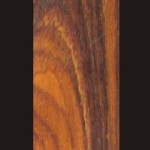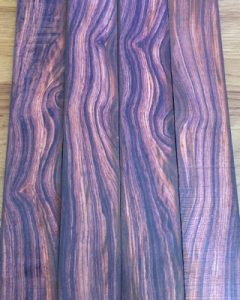COCOBOLO
LATIN: DALBERGIA RETUSA ORIGIN: CENTRAL AMERICA
After the ban on Brazilian Rosewood (Dalbergia nigra), Cocobolo became the new sweetheart of the Rosewoods. Beloved for the rich, varying colors and swirling grain patterns it has been a favorite for woodturners and luthiers for many years. With the addition of this species to the CITES II appendix the availability is becoming much more difficult. We do have a very good inventory of pre-CITES material that is still for sale. Get some before its all gone!
Below is a video taken by Rocky in 2013, explaining the varying color of Cocobolo.
WOOD TYPE
Exotic hardwood
TEXTURE
Fine, even texture with good luster
GRAIN PATTERN
Straight to interlocked, some pieces are figured
HEALTH RISKS
Common allergen, can cause skin, eye or respiratory irritation
COLOR
Widely varying, from red, orange, gold, brown with streaks of black or purple, sap is a contrasting pale yellow
 Cocobolo
Cocobolo
Some people consider cocobolo to be the classic rosewood. It comes in many shades and colors. It is a rosewood that usually has a fair amount of natural oil in the wood. Mexican cocobolo can also have more or less orange or brown, straight or wavy lines, many lines or few lines. Each piece varies a little.

Cocobolo
Dalbergia retusa
Cocobolo is a highly prized wood with all woodworkers due to the wide range of colours that are present in the wood. Cocoblo is also extremely dense meaning that is hard wearing and will polish to an impressive shine, it is always different in appearance from one piece to another. The heartwood ranges from dark brown to light brown with reds, yellows and purple streaks.
COCOBOLO
LATIN: DALBERGIA RETUSA ORIGIN: CENTRAL AMERICA
After the ban on Brazilian Rosewood (Dalbergia nigra), Cocobolo became the new sweetheart of the Rosewoods. Beloved for the rich, varying colors and swirling grain patterns it has been a favorite for woodturners and luthiers for many years. With the addition of this species to the CITES II appendix the availability is becoming much more difficult. We do have a very good inventory of pre-CITES material that is still for sale. Get some before its all gone!
Below is a video taken by Rocky in 2013, explaining the varying color of Cocobolo.
WOOD TYPE
Exotic hardwood
TEXTURE
Fine, even texture with good luster
GRAIN PATTERN
Straight to interlocked, some pieces are figured
HEALTH RISKS
Common allergen, can cause skin, eye or respiratory irritation
COLOR
Widely varying, from red, orange, gold, brown with streaks of black or purple, sap is a contrasting pale yellow

